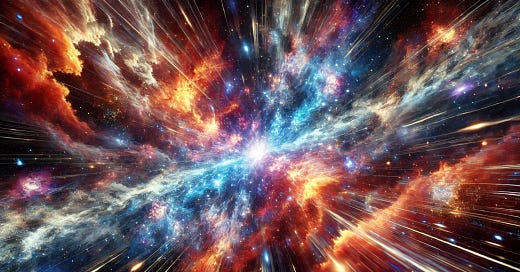the universe is expanding
what physics, grief, and fungal networks can teach us about activism that gives back
Activism—whether for justice, environmental healing, or collective transformation—often feels like an uphill battle against forces too large to change.
The language we use reflects this:
🚫 Minimize harm.
🚫 Reduce suffering.
🚫 Fight injustice.
🚫 Resist oppression.
There is an unspoken assumption that the best we can do is cause less harm than before.
Mathematically, when you minimize a harm function, the best you can do is zero.
The best possible outcome is nonexistence—a state where we do not make things worse, but we also do not make things better.
The natural world does not operate on a minimization function.
The universe itself is an ever-expanding system, constantly increasing in complexity, diversity, and possibility.
first, collapse
We are made of star-stuff. We are a way for the cosmos to know itself.
When a star collapses, it does not simply vanish.
Its death—its explosion—creates the very elements that form life itself.
The oxygen we breathe, the iron in our blood, the calcium in our bones—all were forged in the hearts of dying stars.
In Tibetan Buddhism, the bardo—the space between death and rebirth—is not an end, but a passage of transformation. It presents both peril and opportunity, and can be successfully navigated through awareness cultivated by spiritual practice.
Transformation and rebirth can be witnessed all around us.
Energy cannot be created or destroyed, it can only be transferred or transformed from one form to another.
The sky does not try to contain the storm. It lets the rain fall freely. That rain nourishes the soil where plants grow, becoming food for insects, animals, and people. And life begins again.
…
Many activists who devote themselves to change carry a deep grief.
Grief for what has been lost, for what is being destroyed, and for what may never be restored.
Grief is not a force of destruction, but of creation. The pain of loss is inseparable from the love that preceded it.
In many traditions, grief is not seen as a burden to carry alone, nor as something to be overcome.
It is understood as a natural and necessary current in the river of life. A force that moves through us and re-shapes the landscape of our being.
then, expand
If the universe is always expanding, if stars push outward and galaxies stretch the fabric of existence, then why should activism be shrinking and contracting?
Why should our efforts be guided by restraint when everything we come from— matter, energy, time—moves toward greater complexity, greater expression, and greater connection?
…
In traditions where the Earth is seen as kin, existence is not something to apologize for. But it is also not something to take thoughtlessly.
The most intelligent systems—forests, rivers, fungal networks—expand, not recklessly, but in ways that strengthen the whole.
A tree does not grow endlessly in pursuit of the most sunlight; it extends its roots but also communicates with its neighbors, adjusting, sharing, ensuring the survival of the ecosystem that sustains it.
A river changes course when needed, moving with the landscape, rather than against it.
Mycelial networks spread underground, not in greed, but in collaboration—feeding and connecting life beneath the surface.
…
Purposeful expansion is an existence that gives back more than it takes.
Purposeful expansion is active participation in the co-creation of consciousness.
Purposeful expansion is lusting for the ugly, raw, un-loved corners of the lived experience.
…
The universe does not contract to preserve itself. It expands in ways that allow new structures to emerge, new forms to take hold, and new relationships to develop.
Every atom in our bodies was forged in the death of a star.
Every breath we take is part of a cycle billions of years in the making.
The most enduring forces in nature are those that expand, adapt, evolve, and offer something back.
Life is not a burden. It is an opportunity to participate—to build, to sustain, to create.
now, breathe
To our lovers, we do not say “Today, I tried to shrink myself to nothing in order to hurt you as little as possible.”
Instead, we say “Look, what a beautiful thing I have made with my love for you. A poem. A painting. A meal. A child. A family. A joke. An adventure. A song. A lifetime.”
Love is a creative force. Everything that follows from love—grief, heartache, righteous anger—is also a creative force.
Maybe activism feels so hard because we are trying to shrink ourselves while the universe is expanding.






Bri, this was absolutely incredible. Thank you for writing it and making it available to your readers. This piece contained so much wisdom and food for thought, and this point was especially resonant for me: “…activism doesn’t have to fit a single mold. Your best contributions will come from aligning your activism with who you naturally are.” This isn’t a message we hear often enough, and it’s so true.
LOVE your blog!!!!!!!!!!!!!
Grief is part of the human condition, and we ignore it at our peril. So too is joy and exuberance, and those also are necessary ingredients for the effort of creating the future we desire.
I've been involved in various forms of political and social activism in various ways for over 50 years and something I feel is a very important part of activism for it to be successful at making positive change is to have a culture and language that valorize success: to speak and express visions of VICTORY, to have a culture of positive associations with the righteousness of power in the service of creation.
Some music to consider, which often combine grief and inspiration to victory:
- There Is Power in a Union (Billy Bragg)
- I'm Gonna Be an Engineer (Peggy Seeger)
- Solidarity Forever (Ralph Chaplin)
- The Sinking of the Reuben James (Woody Guthrie)